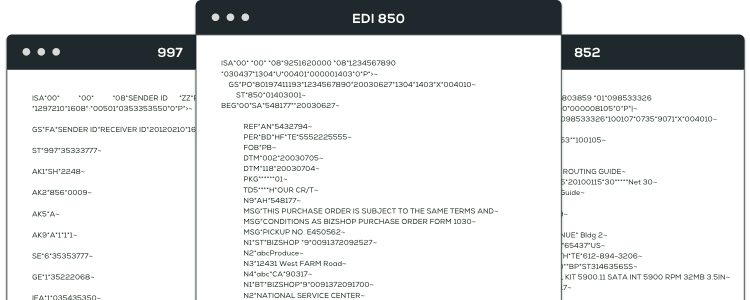Purchase Order
EDI 850 or EDI 875

Common EDI transactions
What is a purchase order?
There are two broad types of EDI purchase order documents, split between the EDIFACT and ANSI X12 standards. EDIFACT is the standard advocated by the UN, and is used in Australia, New Zealand, Europe, and parts of Asia, and uses a single document to cover all purchase order instances known as ‘ORDERS.’ The ANSI X12 standard is used in North America, and has two EDI purchase order document types, the 850 and 875.
Under EDIFACT, as used in Australia
– The ORDERS document is used in all instances. This is analogous to the ANSI X12 ‘850’ invoice, but it accommodates all circumstances.
Under ANSI X12, as used in North America
– The 850 is more widely used in general merchandise.
– The 875 is grocery focused.
The key data elements included in a purchase order:
- Purchase order number
- Purchase order date
- Location(s) where the product or services should be supplied to
- Requested ship and/or delivery date
- Product Item Identifiers/Services such as UPC/EAN/GTIN needed, with their respective quantities
Additional data that may also be included in the purchase order:
- Carrier and service levels, INCOTERMS
- Vendor number
- Item price
- Expected charges and/or allowances
- Additional item identifiers such as buyer item number and vendor part number
- Item description
- Additional dates (Ex: cancel by dates)
Benefits of using an EDI purchase order ‘ORDERS’ or 850
There are benefits to both the purchaser and the supplier of implementing electronic trading of the purchase order. Many of these are dependent on how automated and integrated the transaction is for both parties. Some of the benefits that can be realised include:
- Reduction in volume of paper flow and gain operating efficiencies through reduced time requirements to complete transactions by both parties
- Reduction in administrative time spent manually submitting orders (buyer) and manually receiving and entering purchase orders (supplier) allowing for resources to focus on value added work
- Elimination of data entry errors associated with manual processes
- Potentially increases the speed of fulfilment and supports the ability for the retailer to lower their on hand inventory
Want to learn more about specific EDI files?
Here’s a long list of EDI transactions commonly used in retail.
Eliminate the expense of manual processes.
Remove the time and effort of taking it on yourself. Start here.